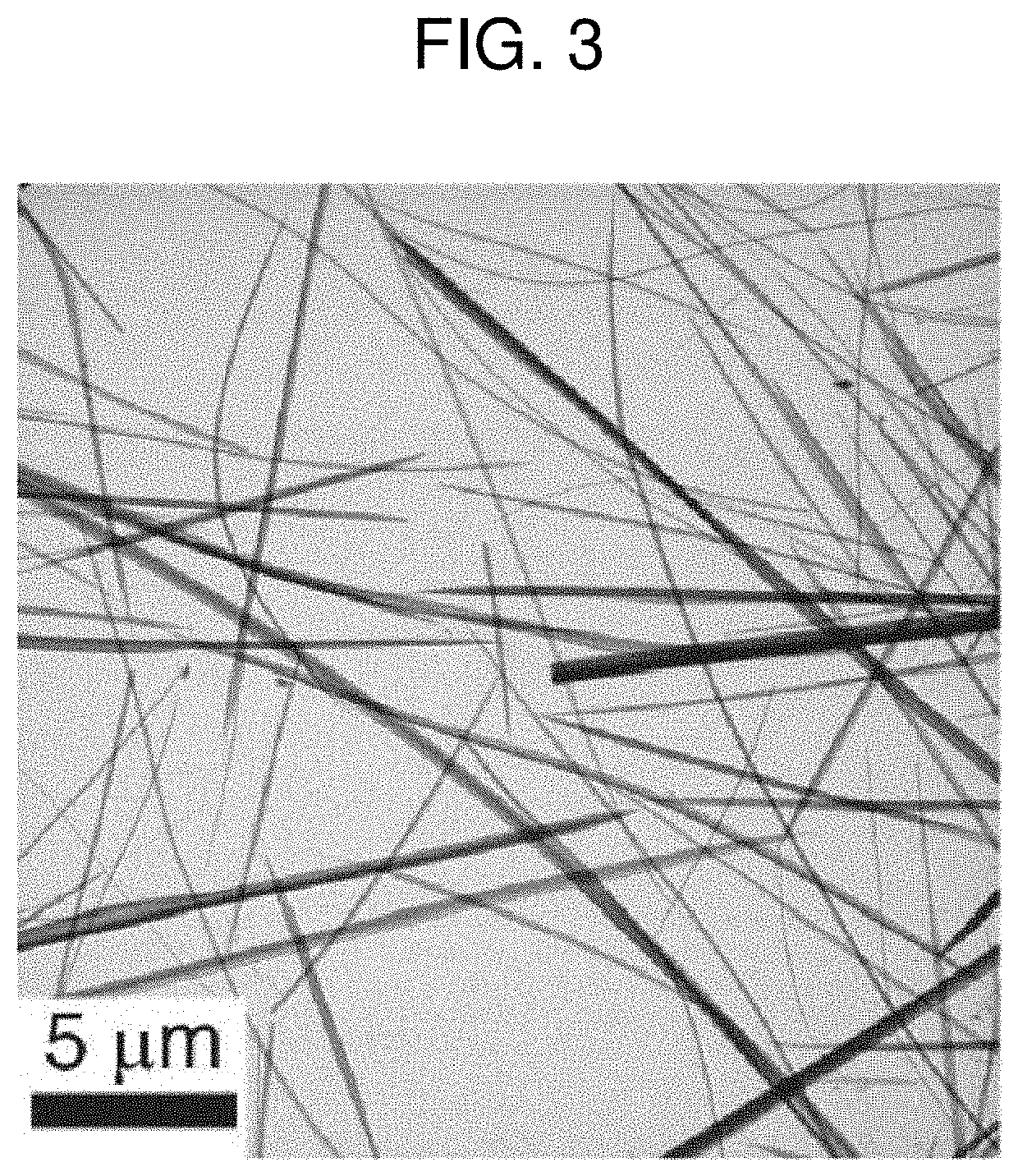Micro-nanostructure manufactured using amorphous nanostructure and manufacturing method therefor
- Summary
- Abstract
- Description
- Claims
- Application Information
AI Technical Summary
Benefits of technology
Problems solved by technology
Method used
Image
Examples
preparation example 1
ous Nanostructure
[0067]25 mg of CuCl2 used as a first metal precursor and 25 mg of a thiourea powder used as a bonding functional group were put into a beaker. 100 ml of ethanol, which is a polar solvent, was put into the beaker. A solution in which the CuCl2, thiourea, and ethanol were mixed was ultrasonically dispersed at room temperature. As a result of the dispersion, amorphous copper-chloride nanowires including S, N, C, and H and having Cu—Cl as a main chain were synthesized within 1 to 2 minutes. The amorphous copper-chloride nanowires may be used for the manufacture of metal nanoparticles.
[0068]FIGS. 3 and 4 are a TEM image and an EDS mapping image of amorphous nanowires prepared according to Preparation Example 1 of the present invention.
[0069]Referring to FIGS. 3 and 4, amorphous copper-chloride nanowires appear. Further, when the manufactured amorphous nanowires were measured by EDS, the atomic composition ratio of Cu:S:N:Cl was found to be 1:1:2:1. Cu and Cl are derived ...
preparation example 2
s Types of Crystalline Metal Nanoparticles
[0070]Each second metal precursor is prepared. The prepared second metal precursors include a second metal element having a higher standard reduction potential than Cu, which is a central metal of the amorphous nanowires of Preparation Example 1. Each second metal precursor is ruthenium (□) chloride hydrate, a rhodium (□) nitrate solution, a palladium (□) chloride solution, silver nitrate, osmium (□) chloride trihydrate, iridium (□) chloride hydrate, a chloroplatinic acid solution or a gold (□) chloride solution.
[0071]Each of these secondary metal precursors is dissolved in 200 ml of ethanol, which is a polar solvent, at room temperature for 3 minutes. After each ethanol solution including the second metal precursors is placed in a beaker including the amorphous copper-chloride nanowires produced in Preparation Example 1, crystalline metal nanoparticles are manufactured by stirring the resulting mixture for several minutes.
[0072]The molar ma...
preparation example 3
y Nanoparticles
[0075]In the present Preparation Example, alloy nanoparticles including two types of metals are formed. For this purpose, a rhodium (□) nitrate solution, a palladium (□) chloride solution, a chloroplatinic acid solution, osmium (□) chloride trihydrate, and a gold (□) chloride solution, which are second metal precursor, are each suitably dissolved in 200 ml of ethanol for a desired alloy type at room temperature. A mixed solution is formed by mixing a solution including two types of second metal precursors. The composition of the alloy nanoparticles manufactured may vary depending on the type of mixed solution formed.
[0076]Furthermore, the amorphous copper-chloride nanowires of Preparation Example 1 are put into the formed mixed solution and stirred. Through this, various types of alloy nanoparticles may be obtained, and each alloy nanoparticle is provided in a pattern in which two types of metal elements are mixed.
[0077]FIG. 6 is a high-resolution STEM image and EDS m...
PUM
 Login to View More
Login to View More Abstract
Description
Claims
Application Information
 Login to View More
Login to View More - R&D
- Intellectual Property
- Life Sciences
- Materials
- Tech Scout
- Unparalleled Data Quality
- Higher Quality Content
- 60% Fewer Hallucinations
Browse by: Latest US Patents, China's latest patents, Technical Efficacy Thesaurus, Application Domain, Technology Topic, Popular Technical Reports.
© 2025 PatSnap. All rights reserved.Legal|Privacy policy|Modern Slavery Act Transparency Statement|Sitemap|About US| Contact US: help@patsnap.com



